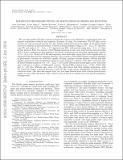Files in this item
Rotation in the Pleiades with K2. III. Speculations on origins and evolution
Item metadata
| dc.contributor.author | Stauffer, John | |
| dc.contributor.author | Rebull, Luisa | |
| dc.contributor.author | Bouvier, Jerome | |
| dc.contributor.author | Hillenbrand, Lynne A. | |
| dc.contributor.author | Collier Cameron, Andrew | |
| dc.contributor.author | Pinsonneault, Marc | |
| dc.contributor.author | Aigrain, Suzanne | |
| dc.contributor.author | Barrado, David | |
| dc.contributor.author | Bouy, Herve | |
| dc.contributor.author | Ciardi, David | |
| dc.contributor.author | Cody, Ann Marie | |
| dc.contributor.author | David, Trevor | |
| dc.contributor.author | Micela, Giusi | |
| dc.contributor.author | Soderblom, David | |
| dc.contributor.author | Somers, Garrett | |
| dc.contributor.author | Stassun, Keivan G. | |
| dc.contributor.author | Valenti, Jeff | |
| dc.contributor.author | Vrba, Frederick J. | |
| dc.date.accessioned | 2016-09-06T15:31:35Z | |
| dc.date.available | 2016-09-06T15:31:35Z | |
| dc.date.issued | 2016-10-11 | |
| dc.identifier | 243386131 | |
| dc.identifier | 4ed2b526-b364-4159-b887-8b238e7836c7 | |
| dc.identifier | 84994627640 | |
| dc.identifier | 000386139400003 | |
| dc.identifier.citation | Stauffer , J , Rebull , L , Bouvier , J , Hillenbrand , L A , Collier Cameron , A , Pinsonneault , M , Aigrain , S , Barrado , D , Bouy , H , Ciardi , D , Cody , A M , David , T , Micela , G , Soderblom , D , Somers , G , Stassun , K G , Valenti , J & Vrba , F J 2016 , ' Rotation in the Pleiades with K 2. III. Speculations on origins and evolution ' , Astronomical Journal , vol. 152 , no. 5 , 115 . https://doi.org/10.3847/0004-6256/152/5/115 | en |
| dc.identifier.issn | 0004-6256 | |
| dc.identifier.other | ArXiv: http://arxiv.org/abs/1606.00057v2 | |
| dc.identifier.other | ORCID: /0000-0002-8863-7828/work/58531389 | |
| dc.identifier.uri | https://hdl.handle.net/10023/9448 | |
| dc.description.abstract | We use high quality K2 light curves for hundreds of stars in the Pleiades to understand better the angular momentum evolution and magnetic dynamos of young, low mass stars. The K2 light curves provide not only rotational periods but also detailed information from the shape of the phased light curve not available in previous studies. A slowly rotating sequence begins at (V−Ks)0 ∼ 1.1 (spectral type F5) and ends at (V−Ks)0 ∼ 3.7 (spectral type K8), with periods rising from ∼2 to ∼11 days in that interval. 52% percent of the Pleiades members in that color interval have periods within 30% of a curve defining the slow sequence; the slowly rotating fraction decreases significantly redward of (V−Ks)0=2.6. Nearly all of the slow-sequence stars show light curves that evolve significantly on timescales less than the K2 campaign duration. The majority of the FGK Pleiades members identified as photometric binaries are relatively rapidly rotating, perhaps because binarity inhibits star-disk angular momentum loss mechanisms during pre-main sequence evolution. The fully convective, late M dwarf Pleiades members (5.0 < (V−Ks)0 < 6.0) nearly always show stable light curves, with little spot evolution or evidence of differential rotation. During PMS evolution from ∼3 Myr (NGC2264 age) to ∼125 Myr (Pleiades age), stars of 0.3 M⊙ shed about half their angular momentum, with the fractional change in period between 3 and 125 Myr being nearly independent of mass for fully convective stars. Our data also suggest that very low mass binaries form with rotation periods more similar to each other and faster than would be true if drawn at random from the parent population of single stars. | |
| dc.format.extent | 22 | |
| dc.format.extent | 1360610 | |
| dc.language.iso | eng | |
| dc.relation.ispartof | Astronomical Journal | en |
| dc.subject | Open clusters and associations: individual (Pleiades) | en |
| dc.subject | Stars: rotation | en |
| dc.subject | QB Astronomy | en |
| dc.subject | QC Physics | en |
| dc.subject | NDAS | en |
| dc.subject.lcc | QB | en |
| dc.subject.lcc | QC | en |
| dc.title | Rotation in the Pleiades with K2. III. Speculations on origins and evolution | en |
| dc.type | Journal article | en |
| dc.contributor.sponsor | Science & Technology Facilities Council | en |
| dc.contributor.institution | University of St Andrews. School of Physics and Astronomy | en |
| dc.identifier.doi | 10.3847/0004-6256/152/5/115 | |
| dc.description.status | Peer reviewed | en |
| dc.identifier.grantnumber | ST/M001296/1 | en |
This item appears in the following Collection(s)
Items in the St Andrews Research Repository are protected by copyright, with all rights reserved, unless otherwise indicated.

